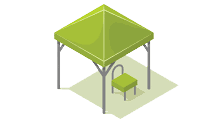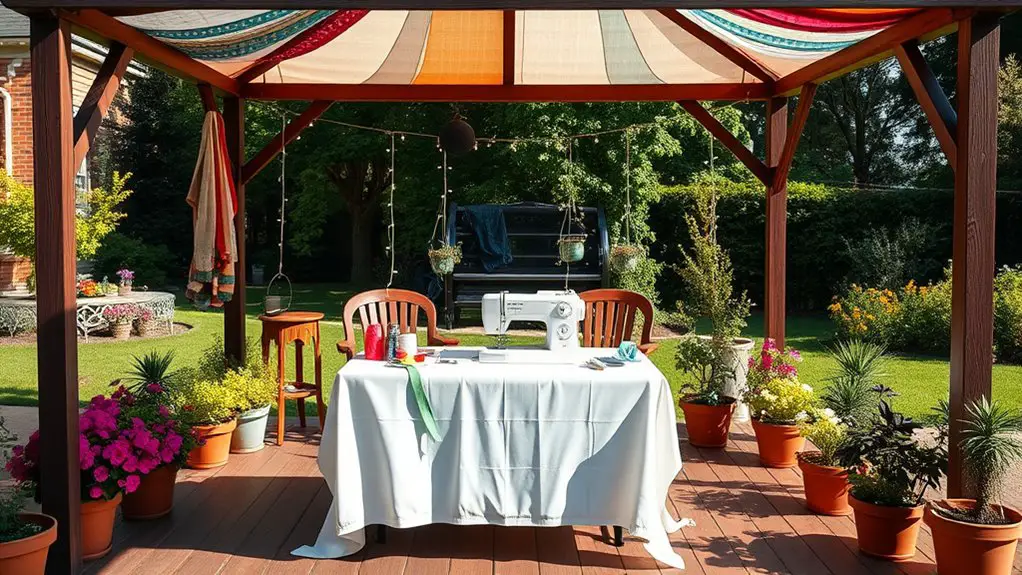To set up your gazebo for a DIY fashion workshop, choose a flat, private location with good sunlight exposure. Select a size and style that suits your activities and aesthetic. Guarantee ample natural and adjustable lighting for creativity, and organize materials in labeled bins for easy access. Create comfortable seating arrangements that foster collaboration. Don’t forget to plan for weather contingencies with waterproof covers and a backup indoor space. Discover more tips to elevate your workshop experience!
Selecting the Ideal Location for Your Gazebo
When you’re choosing the perfect spot for your gazebo, have you considered how the location will impact your DIY workshop? The right location can enhance your outdoor ambiance and make your creative process more enjoyable. Look for a flat, stable area that’s accessible yet offers some privacy. Avoid spots with heavy foot traffic, as distractions can interrupt your flow. Think about sunlight—too much can overpower your workspace, while too little might hinder your projects. Also, consider nearby trees; they provide shade but can drop leaves or sap. Finally, think about wind direction to minimize debris blowing into your workspace. By weighing these location considerations, you’ll create an inspiring oasis for your DIY endeavors. Additionally, the orientation of the backyard affects sun and wind exposure, which can significantly influence your comfort while working.
Choosing the Right Size and Style of Gazebo
How do you envision your DIY workshop taking shape within your gazebo? Choosing the right size and style is essential for your creative space. Consider gazebo styles that resonate with your aesthetic—whether it’s traditional, modern, or rustic. Think about how many participants you’ll have and what activities you’ll host. Size considerations are important; a larger gazebo provides room for tables, materials, and movement, while a smaller one might feel cozier but could limit your setup. Aim for a balance that encourages creativity without feeling cramped. Remember, it’s all about creating a welcoming environment that inspires freedom and expression, so choose a gazebo that aligns with your vision for the perfect DIY workshop. Additionally, a larger gazebo can enhance outdoor living space, allowing for a more comfortable and functional workshop setting.
Ensuring Proper Lighting for Creativity
What’s the best way to guarantee your DIY workshop feels inviting and energizing? Proper lighting! Start by maximizing natural lighting. Position your gazebo in a spot where sunlight pours in, illuminating your workspace. If the sun isn’t always shining, bring in adjustable fixtures. These allow you to customize the lighting based on your needs and mood. Additionally, consider incorporating a ceiling fan to enhance air circulation and keep your workspace comfortable during warmer days. Check out the table below for lighting options:
| Type of Lighting | Benefits |
|---|---|
| Natural Lighting | Boosts creativity and focus |
| Adjustable Fixtures | Versatile and mood-enhancing |
| Soft Ambient Lights | Creates a cozy atmosphere |
Organizing Your Materials and Supplies
With the right lighting setting the stage, it’s time to focus on organizing your materials and supplies. An effective supply organization strategy guarantees you can easily access everything you need, fostering creativity. Start by taking a material inventory, listing all your fabrics, tools, and accessories. This not only helps you keep track of what you have but also inspires ideas for your workshop projects.
Organizing your materials fosters creativity; start with an inventory of fabrics, tools, and accessories to inspire your DIY projects.
Here are some tips to help you stay organized:
- Use labeled bins or baskets for different materials.
- Create a designated workspace for cutting, sewing, and assembling.
- Keep essential tools within arm’s reach to avoid interruptions.
- Regularly update your material inventory to reflect your current supplies.
- Consider setting up a gazebo with mosquito netting to ensure a comfortable and bug-free environment for your workshop.
With everything in place, you’re ready to plunge into your DIY fashion workshop!
Creating Comfortable Seating Arrangements
Comfortable seating arrangements are essential for a productive DIY workshop, as they guarantee you and your participants can focus on creativity without discomfort. Start by incorporating cushioned seating options like bean bags, folding chairs with padding, or even outdoor lounge chairs. These choices not only enhance comfort but also add a relaxed vibe to your space. Consider creative layouts that encourage interaction, such as circular or semi-circular seating to foster discussion and collaboration. You might also mix different seating styles to keep the atmosphere dynamic and inviting. Remember, the goal is to create a welcoming environment where everyone feels free to express their ideas and explore their creativity, so make sure your seating complements that vision. Additionally, incorporating comfortable and functional furniture will ensure that your participants can focus on their DIY projects without any distractions.
Setting Up Workstations for Collaboration
To create an effective DIY workshop, you’ll want to design collaborative spaces that encourage teamwork and creativity. Think about how to optimize tool accessibility so everyone can easily reach what they need, reducing downtime and frustration. By setting up workstations that promote interaction, you’ll enhance the overall experience for everyone involved. Additionally, ensure that your setup is in a weather resistant gazebo, providing reliable shelter and comfort for all participants, regardless of the season.
Design Collaborative Spaces
Creating an inviting and functional collaborative space is essential for a successful DIY workshop. A creative layout encourages interaction and keeps the energy flowing. Here are some tips to set up your workspace:
- Flexible workstations: Arrange tables in a circular or U-shape to foster conversation.
- Collaborative tools: Provide shared supplies, such as fabric, scissors, and markers, easily accessible to everyone.
- Comfortable seating: Mix and match seating options to promote a relaxed atmosphere, allowing participants to move around freely.
- Visual inspiration: Hang mood boards or fabric swatches nearby to spark creativity and keep ideas flowing.
Optimize Tool Accessibility
While setting up your workshop, ensuring easy access to tools can greatly enhance collaboration and productivity. Start by organizing your tool storage effectively. Use labeled bins or pegboards for quick identification and retrieval. Arrange your equipment layout to minimize movement; keep frequently used tools within arm’s reach. Consider creating designated workstations for different tasks—this not only streamlines the process but also encourages teamwork. If space allows, set up a central tool station where everyone can gather and share resources. Remember, a clutter-free environment fosters creativity, so regularly reassess your setup. By optimizing tool accessibility, you’ll create a dynamic atmosphere where ideas flow freely, and everyone can contribute to the collective project seamlessly.
Incorporating Decorative Elements for Inspiration
As you set the stage for your DIY workshop, incorporating decorative elements can greatly enhance your creative environment. Think about how these touches can inspire you and your guests. Here are some ideas to contemplate:
- Decorative fabrics: Use vibrant tablecloths or drapes to add color and texture.
- Artistic displays: Showcase your favorite projects or mood boards to spark creativity.
- Mood lighting: String fairy lights or lanterns to create a cozy atmosphere.
- Plants or flowers: Bring in some greenery for a revitalizing and lively touch. Additionally, consider draping outdoor fabric to enhance the overall aesthetic of the gazebo, making it a more inviting space for creativity.
Planning for Weather Contingencies
When you’re setting up your gazebo for a DIY workshop, it’s essential to plan for unexpected weather. You’ll want to take into account weatherproofing your gazebo and having alternative indoor locations ready just in case Mother Nature doesn’t cooperate. By being prepared, you can keep your project on track and enjoy a stress-free creative space. Additionally, consider using a gazebo with waterproof materials to ensure maximum protection from rain and moisture.
Weatherproofing Your Gazebo
To guarantee your DIY workshop runs smoothly, it’s essential to weatherproof your gazebo, especially if you’re planning to host it outdoors. You don’t want unexpected rain or wind to ruin your creative flow, so take some proactive steps.
- Use weather resistant materials for the structure to withstand various conditions.
- Invest in waterproof covers to shield your workspace and supplies.
- Consider adding sidewalls for extra protection against wind and rain.
- Keep some tarps handy for quick fixes in case of sudden weather changes.
Alternative Indoor Locations
While you might be excited about hosting your DIY workshop in the gazebo, it’s wise to have a backup plan in case the weather takes a turn. Consider alternative indoor locations that can spark your creativity. A spacious garage, a community center, or even a large living room can serve as effective setups. Look for spaces with good lighting and room for movement; these elements can provide indoor inspiration that fuels your workshop’s energy. Don’t forget to arrange tables and chairs for comfort, and make sure you have enough power outlets for tools. By preparing these alternative setups, you can assure a fabulous experience, rain or shine, keeping the spirit of creativity alive no matter the weather.
Ensuring Accessibility for All Participants
Making certain that all participants can access your DIY workshop is essential for creating an inclusive environment. You want everyone to feel welcome and comfortable, so keep these tips in mind:
- Provide wheelchair access: Make sure the path to your gazebo is clear and flat, with ramps if necessary.
- Sensory considerations: Create a calm space with minimal distractions. Consider using soft lighting and quiet zones.
- Clear signage: Use large, easy-to-read signs to guide participants to facilities like restrooms and exits.
- Seating options: Offer a variety of seating arrangements, including chairs with arms for support and spaces for those who prefer to sit on the ground. Additionally, ensure your gazebo location considers sun and shade exposure to maintain a comfortable temperature throughout the workshop.
Frequently Asked Questions
What Should I Wear to a DIY Fashion Workshop?
For your DIY fashion workshop, you’ll want comfortable attire that’ll let you move freely. Consider breathable fabric choices, like cotton or linen, to keep you cool while you create. Stay stylish and practical!
How Can I Promote My Fashion Workshop Effectively?
To promote your fashion workshop effectively, leverage social media for engaging posts and local advertising through flyers or community boards. Connect with your audience and create excitement around your workshop’s unique offerings.
What Safety Precautions Should I Consider During the Workshop?
When creativity flows, safety shouldn’t take a backseat. Guarantee you’ve got safety gear on-hand, and familiarize everyone with emergency procedures. A little preparation goes a long way in keeping your workshop fun and secure.
How Can I Handle Multiple Skill Levels Among Participants?
To handle multiple skill levels, start with a skill assessment. Then, plan inclusive group activities that encourage collaboration. This way, everyone can learn from each other, fostering a supportive environment where creativity thrives.
What Types of Refreshments Should I Provide for Attendees?
For refreshments, consider offering light snacks like fruit skewers and veggie trays. For beverage options, iced tea, lemonade, and flavored water are invigorating ideas. These choices keep everyone energized and engaged throughout your event!

